《有机化学》课程PPT教学课件(Organic Chemistry,5th Edition,L. G. Wade, Jr.,Prentice Hall)Chapter 02 Structure and Properties of Organic Molecules
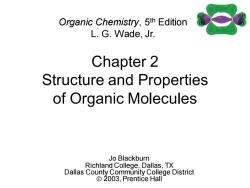
Organic Chemistry,5th Edition L.G.Wade,Jr. Chapter 2 Structure and Properties of Organic Molecules Jo Blackburn Richland College,Dallas,TX Dallas County Community College District ©20o3,Prentice Hall
Chapter 2 Structure and Properties of Organic Molecules Organic Chemistry, 5th Edition L. G. Wade, Jr. Jo Blackburn Richland College, Dallas, TX Dallas County Community College District © 2003, Prentice Hall
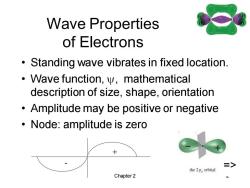
Wave Properties of Electrons Standing wave vibrates in fixed location. Wave function,y,mathematical description of size,shape,orientation Amplitude may be positive or negative Node:amplitude is zero > the 2p,orbital Chapter 2
Chapter 2 2 Wave Properties of Electrons • Standing wave vibrates in fixed location. • Wave function, , mathematical description of size, shape, orientation • Amplitude may be positive or negative • Node: amplitude is zero + _ + - =>
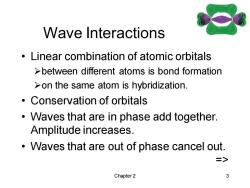
Wave Interactions Linear combination of atomic orbitals >between different atoms is bond formation >on the same atom is hybridization. Conservation of orbitals Waves that are in phase add together. Amplitude increases. Waves that are out of phase cancel out. > Chapter 2 3
Chapter 2 3 Wave Interactions • Linear combination of atomic orbitals ➢between different atoms is bond formation ➢on the same atom is hybridization. • Conservation of orbitals • Waves that are in phase add together. Amplitude increases. • Waves that are out of phase cancel out. =>
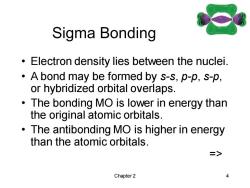
Sigma Bonding Electron density lies between the nuclei. A bond may be formed by s-s,p-p,s-p, or hybridized orbital overlaps. The bonding MO is lower in energy than the original atomic orbitals. The antibonding MO is higher in energy than the atomic orbitals. => Chapter 2 4
Chapter 2 4 Sigma Bonding • Electron density lies between the nuclei. • A bond may be formed by s-s, p-p, s-p, or hybridized orbital overlaps. • The bonding MO is lower in energy than the original atomic orbitals. • The antibonding MO is higher in energy than the atomic orbitals. =>
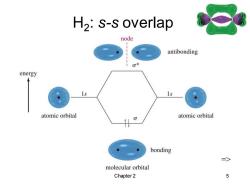
H2:s-s overlap node antibonding 0米 energy atomic orbital atomic orbital bonding => molecular orbital Chapter 2 5
Chapter 2 5 H2 : s-s overlap =>
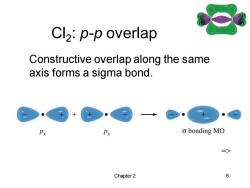
Cl2:p-p overlap Constructive overlap along the same axis forms a sigma bond. Px o bonding MO Chapter 2 6
Chapter 2 6 Cl2 : p-p overlap => Constructive overlap along the same axis forms a sigma bond
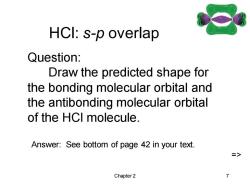
HCI:s-p overlap Question: Draw the predicted shape for the bonding molecular orbital and the antibonding molecular orbital of the HCI molecule. Answer:See bottom of page 42 in your text. => Chapter 2 7
Chapter 2 7 HCl: s-p overlap Question: Draw the predicted shape for the bonding molecular orbital and the antibonding molecular orbital of the HCl molecule. Answer: See bottom of page 42 in your text. =>
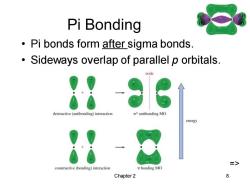
Pi Bonding Pi bonds form after sigma bonds. Sideways overlap of parallel p orbitals. node destructive (antibonding)interaction *antibonding MO energy constructive (bonding)interaction a bonding MO Chapter 2
Chapter 2 8 Pi Bonding • Pi bonds form after sigma bonds. • Sideways overlap of parallel p orbitals. =>

Multiple Bonds A double bond (2 pairs of shared electrons) consists of a sigma bond and a pi bond. A triple bond (3 pairs of shared electrons) consists of a sigma bond and two pi bonds. half of T bond C o bond H H H half of T bond Chapter 2 9
Chapter 2 9 Multiple Bonds • A double bond (2 pairs of shared electrons) consists of a sigma bond and a pi bond. • A triple bond (3 pairs of shared electrons) consists of a sigma bond and two pi bonds. =>
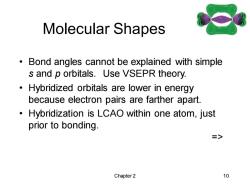
Molecular Shapes Bond angles cannot be explained with simple s and p orbitals.Use VSEPR theory. Hybridized orbitals are lower in energy because electron pairs are farther apart. Hybridization is LCAO within one atom,just prior to bonding. => Chapter 2 10
Chapter 2 10 Molecular Shapes • Bond angles cannot be explained with simple s and p orbitals. Use VSEPR theory. • Hybridized orbitals are lower in energy because electron pairs are farther apart. • Hybridization is LCAO within one atom, just prior to bonding. =>
按次数下载不扣除下载券;
注册用户24小时内重复下载只扣除一次;
顺序:VIP每日次数-->可用次数-->下载券;
- 《有机化学》课程PPT教学课件(Organic Chemistry,5th Edition,L. G. Wade, Jr.,Prentice Hall)Chapter 01 Introduction and Review.ppt
- 《有机化学》课程教学课件(McMurry’s Organic Chemistry, 6th edition)Chapter 10 Alkyl Halides.pdf
- 《有机化学》课程教学课件(McMurry’s Organic Chemistry, 6th edition)Chapter 09 Stereochemistry.pdf
- 《有机化学》课程教学课件(McMurry’s Organic Chemistry, 6th edition)Chapter 08 Alkynes.pdf
- 《有机化学》课程教学课件(McMurry’s Organic Chemistry, 6th edition)Chapter 07 Alkenes - Reactions and Synthesis.pdf
- 《有机化学》课程教学课件(McMurry’s Organic Chemistry, 6th edition)Chapter 06 Alkenes - Structure and Reactivity.pdf
- 《有机化学》课程教学课件(McMurry’s Organic Chemistry, 6th edition)Chapter 05 An Overview of Organic Reactions.pdf
- 《有机化学》课程教学课件(McMurry’s Organic Chemistry, 6th edition)Chapter 04 Stereochemistry of Alkanes and Cycloalkanes.pdf
- 《有机化学》课程教学课件(McMurry’s Organic Chemistry, 6th edition)Chapter 03 Organic Compounds - Alkanes and Cycloalkanes.pdf
- 《有机化学》课程教学课件(McMurry’s Organic Chemistry, 6th edition)Chapter 02 Polar Covalent Bonds; Acids and Bases.pdf
- 《有机化学》课程教学课件(McMurry’s Organic Chemistry, 6th edition)Chapter 01 Structure and Bonding.pdf
- 西北农林科技大学:《有机化学》课程教学资源(试卷习题)2008—2009学年第二学期ORGANIC CHEMISTRY课程A卷(答案).doc
- 西北农林科技大学:《有机化学》课程教学资源(试卷习题)2008—2009学年第二学期ORGANIC CHEMISTRY课程A卷(试题).doc
- 西北农林科技大学:《有机化学》课程教学资源(试卷习题)2012—2013学年第2学期课程A卷(答案).pdf
- 西北农林科技大学:《有机化学》课程教学资源(试卷习题)2012—2013学年第2学期课程A卷(试题).pdf
- 西北农林科技大学:《有机化学》课程教学资源(试卷习题)2004年有机化学期末测试题B(双语)试题.pdf
- 西北农林科技大学:《有机化学》课程教学资源(试卷习题)2004年有机化学期末测试题B(双语)答案.pdf
- 《有机化学》课程教学资源(参考书籍)Solution manual Organic Chemistry(SIXTH EDITION, 2005, L. G. Wade, Jr., Jan William Simek).pdf
- 《有机化学》课程教学资源(参考书籍)Organic Chemistry, 8th Edition, L . G . WA D E , J R ..pdf
- 《有机化学》课程教学资源(参考书籍)Organic Chemistry(7th Edition)Prentice Hall(2009, L.G. Wade, Jr. Whitman College).pdf
- 《有机化学》课程PPT教学课件(Organic Chemistry,5th Edition,L. G. Wade, Jr.,Prentice Hall)Chapter 26 Synthetic Polymers.ppt
- 《有机化学》课程PPT教学课件(Official PPT of Organic Chemistry 6th LG Wade by Prentice Hall,L. G. Wade, Jr.)Chapter 01 Introduction and Review.ppt
- 《有机化学》课程PPT教学课件(Official PPT of Organic Chemistry 6th LG Wade by Prentice Hall,L. G. Wade, Jr.)Chapter 02 Structure and Properties of Organic Molecules.ppt
- 《有机化学》课程PPT教学课件(Official PPT of Organic Chemistry 6th LG Wade by Prentice Hall,L. G. Wade, Jr.)Chapter 03 Structure and Stereochemistry of Alkanes.ppt
- 《有机化学》课程PPT教学课件(Official PPT of Organic Chemistry 6th LG Wade by Prentice Hall,L. G. Wade, Jr.)Chapter 04 The Study of Chemical Reactions.ppt
- 《有机化学》课程PPT教学课件(Official PPT of Organic Chemistry 6th LG Wade by Prentice Hall,L. G. Wade, Jr.)Chapter 05 Stereochemistry.ppt
- 《有机化学》课程PPT教学课件(Official PPT of Organic Chemistry 6th LG Wade by Prentice Hall,L. G. Wade, Jr.)Chapter 07 Structure and Synthesis of Alkenes.ppt
- 《有机化学》课程PPT教学课件(Official PPT of Organic Chemistry 6th LG Wade by Prentice Hall,L. G. Wade, Jr.)Chapter 08 Alkenes - Reactions of Alkenes.ppt
- 《有机化学》课程PPT教学课件(Official PPT of Organic Chemistry 6th LG Wade by Prentice Hall,L. G. Wade, Jr.)Chapter 09 Alkynes.ppt
- 《有机化学》课程PPT教学课件(Official PPT of Organic Chemistry 6th LG Wade by Prentice Hall,L. G. Wade, Jr.)Chapter 10 Structure and Synthesis of Alcohols.ppt
- 《有机化学》课程PPT教学课件(Official PPT of Organic Chemistry 6th LG Wade by Prentice Hall,L. G. Wade, Jr.)Chapter 11 Reactions of Alcohols.ppt
- 《有机化学》课程PPT教学课件(Official PPT of Organic Chemistry 6th LG Wade by Prentice Hall,L. G. Wade, Jr.)Chapter 12 Infrared Spectroscopy and Mass Spectrometry.ppt
- 《有机化学》课程PPT教学课件(Official PPT of Organic Chemistry 6th LG Wade by Prentice Hall,L. G. Wade, Jr.)Chapter 13 Nuclear Magnetic Resonance Spectroscopy.ppt
- 《有机化学》课程PPT教学课件(Official PPT of Organic Chemistry 6th LG Wade by Prentice Hall,L. G. Wade, Jr.)Chapter 14 Ethers, Epoxides, and Sulfides.ppt
- 《有机化学》课程PPT教学课件(Official PPT of Organic Chemistry 6th LG Wade by Prentice Hall,L. G. Wade, Jr.)Chapter 15 Conjugated Systems, Orbital Symmetry, and Ultraviolet Spectroscopy.ppt
- 《有机化学》课程PPT教学课件(Official PPT of Organic Chemistry 6th LG Wade by Prentice Hall,L. G. Wade, Jr.)Chapter 16 Aromatic Compounds.ppt
- 《有机化学》课程PPT教学课件(Official PPT of Organic Chemistry 6th LG Wade by Prentice Hall,L. G. Wade, Jr.)Chapter 17 Reactions of Aromatic Compounds.ppt
- 《有机化学》课程PPT教学课件(Official PPT of Organic Chemistry 6th LG Wade by Prentice Hall,L. G. Wade, Jr.)Chapter 18 Ketones and Aldehydes.ppt
- 《有机化学》课程PPT教学课件(Official PPT of Organic Chemistry 6th LG Wade by Prentice Hall,L. G. Wade, Jr.)Chapter 19 Amines.ppt
- 《有机化学》课程PPT教学课件(Official PPT of Organic Chemistry 6th LG Wade by Prentice Hall,L. G. Wade, Jr.)Chapter 20 Carboxylic Acids.ppt
